A weekends Drawing – Manchester’s Industrial Landscape ( Charcoal on Paper )
This weekend I gave myself sometime to add a physical Charcoal on cartridge paper drawing to last weeks Digital version in my last post. I wanted to do some work in the style of Trevor Grimshaw as I like his drawings very much and felt there was a lot of value in attempting to produce my own versions, I feel that his use of monochrome with its many varying tones, so carefully worked is wonderful…
So here is my first attempt to produce an A3 size drawing 🙂 I am happy with the results but will keep working hard in order to refine this style of working with Charcoal as a medium ……
I also want to add some Acrylic painting works to the project but for now I am loving using Charcoal 🙂
Charcoal drawing – A tribute to the work of Trevor Grimshaw …….
Following my post yesterday, I have started working with my PC based art application ( Krita ) in order to use its charcoal drawings tools to recreate as best as I can the landscapes style of Trevor Grimshaw.
Tomorrow I will give myself time to work at my desk with actual physical charcoal and chalk, I do feel very much however that a digital method of producing a work of art is just as valid in 2020, as working with physical materials, every mark made on my drawing above is made manually using a Wacom art tablet with an art pen. I often use this method of working to work out just how best to construct drawings and painting, when later it comes to sitting down with a sheet of physical paper or canvas.
Artist from My Home town (Trevor Grimshaw)

Trevor Grimshaw
Open Space
1974
I guess we always, no matter how long we have lived away from our place of birth feel that Home is Home!…
I have lived here in Ireland for almost two decades now but when it come to artists I still have two at the top of my list who lived and worked as artists in or around the greater Manchester area in the UK.
At the top of my list will always be Ls Lowry 🙂 I have a post on his work here Ls Lowry and here, If you want to know more about his life and work, Manchester has a great gallery (The lowry Gallery) dedicated to his life and his art work, its a fantastic Gallery and a great source for his history.
While I love the art work of LS Lowry the art work by my other favourite Manchester artist Travor Grimshaw has always been very much in my mind when I think of amazing drawings from the industrial past of the city Manchester, along with many other surrounding towns which at the time contained industrial landscapes such as Bolton.

Northern Townscape 1974 Trevor Grimshaw 1947-2001 Presented by Christie’s Contemporary Art through the Institute of Contemporary Prints 1975
What I like most about Grimshaw’s work is his ability to limit this images down to a single style and his limited use of materials – along with his his use of moody monochromes. I work a increasingly with drawings these days and love the feeling produced when just using medium’s such as charcoal or pastels along with graphite.
Here its like he knew perfectly well that these limited materials were perfect for representing the smoke and coal dust filled factory landscapes of the English north west and he stayed with these materials for the vast majority of this well know works.
Take this image (Two Telegraph Poles) for example, like a lot of his drawings and painting there is little subject matter in them, if you compare these images to the paintings of LS. lowry, these landscape are empty. There are none of the hundreds of people all going about their activities.
All the art work is done here by empty views that contain some of the most moody drawings I think I have ever seen ….
Here is a full description of Trevor’s life and his working career ….
Life and work
Grimshaw was born in Hyde, Cheshire in 1947 and studied at the Stockport College of Art from 1963 to 1968. He developed a unique style working in oils, charcoal and graphite to produce atmospheric, stylised images of the Northern industrial landscape, mainly in monochrome.
As a child he had a passion for steam engines and trainspotting, which continued into adulthood; for example he made the journey to the scrapyard at Barry in South Wales which held hundreds of steam locomotives awaiting scrapping, and made a personal photographic record of the occasion, 34 photo images being used in his publication “Stilled Life”. Much of his work overall features steam engines.
He spent much of his working career at Manchester advertising agency Stowe Bowden Ltd.[citation needed]
Artistic career
Grimshaw exhibited widely in the UK (including at the Royal Scottish Academy and the Royal Academy in the 1970s) and in the US and Germany. His work was included in the private collections of L.S. Lowry, Edward Heath (two drawings purchased in 1973), the Warburton (Bread) Family and Gerald Kaufman MP., and he is represented in a number of public collections, including The Tate Gallery, Salford Art Gallery, Stockport Art Gallery and Bury Art Gallery.
He illustrated The Singing Street, a book of poems by Mike Harding, and executed limited edition lithographs for Christie’s Contemporary Art. He also did the title slide images for the early BBC Great Railway Journeys of the World series. Artist Geoffrey Key described Grimshaw, a long time friend, as “one of the most important graphic artists working in the north during the last half of the 20th century”.[This quote needs a citation]
While Grimshaw is most celebrated for his black and grey graphite portrayal of post-industrial Britain (e.g. canals, cityscapes, viaducts, steam trains) his portfolio included diverse other subjects such as megaliths, Stonehenge, quarries in North Wales, motorway construction and the solstices (often in combination). Colour treatment was largely reserved for Cheshire landscapes, and pictures of Clarice Cliff ceramics.
L.S.Lowry attended one of his earliest exhibitions, buying three of his major early works to hang alongside his small collection of Pre-Raphaelites. Grimshaw became a regular visitor to Lowry’s home in Mottram.[citation needed]
In 1973 the North West Arts Association published Townscape: Trevor Grimshaw, a book reproducing 30 drawings. In 2004 a major retrospective exhibition was held at Stockport Art Gallery.
By the time of his death, in a house fire in November 2001, Grimshaw had become an alcoholic and a reclusive figure. He held his last show in 1997 in the County Museum and Art Gallery at Prostejov, Moravia, Czech Republic, his 50th show in his 50th year.[citation needed]
Grimshaw’s daughter organised a retrospective exhibition of her father’s work, which took place from February to May 2004 at Stockport Art Gallery.
In June 2014 an exhibition of his paintings, organised by family friend (and owner of the collection).
Ceridwen Grimshaw (Trevor’s youngest daughter) recently discovered negatives taken from Grimshaw’s 1970’s 3 trips to Barry Scrapyard (see above). Almost 100 of these images were unused and 90 will be exhibited at Stockport War Museum and Art Gallery from 11 May 2019 to June 15, titled “Trevor Grimshaw – Unseen Barry Photographs”. Grimshaw’s intention was to show the effects of Barry’s salt air on over 100 steam locomotives awaiting scrapping (although most were eventually saved).
Hans Op de Beeck – Staging Silence
I feel in the need for some inspiration having taken a break from blogging over the last month or two in order to help with some big projects, Now I find myself a little removed from any creative ideas…
So over the next couple of weeks I am going to take a closer look at the work of some of my most loved artists.
Hans Op de Beeck (1969, Turnhout) is a Belgian visual artist who lives and works in Brussels. For over twenty years he has exhibiting internationally.
I first viewed his work at the Butler Gallery in Kilkenny back in 2014 and was instantly taken by his film making, I love his view of the world and the way he reflects on the passage of time in his videos.
Here is just one such a film : Staging Silence
‘Staging Silence’ is based around abstract, archetypal settings that lingered in the memory of the artist as the common denominator of the many similar public places he has experienced. The video images themselves are both ridiculous and serious, just like the eclectic mix of pictures in our minds. The decision to film in black and white heightens this ambiguity: the amateurish quality of the video invokes the legacy of slapstick, as well as the insidious suspense and latent derailmentof film noir. The title refers to the staging of such dormant decors where, in the absence of people, the spectator can project himself as the lone protagonist.
Memory images are disproportionate mixtures of concrete information and fantasies, and in this film they materialise before the spectator’s eyes through anonymous tinkering and improvising hands. Arms appear and disappear at random, manipulating banal objects, scale representations and artificial lighting into alienating yet recognizable locations. These places are no more or less than animated decors for possible stories, evocative visual propositions to the spectator. The film is accompanied by a score which, inspired by the images themselves, has been composed and performed by composer-musician Serge Lacroix.
Looking at Great painting “The Stour”- John Constable, UK 1776 – 1837

CONSTABLE, John
Great Britain 1776 – 1837
The Stour 27 September 1810
oil on canvas
23.8 h x 23.5 w cm
dated ’27 Sepr. 1810′ upper right
John G. Johnson collection, Philadelphia Museum of Art, bequeathed in 1917
Since I returned to Ireland from a holiday in Germany during November, I have found myself turning to my drawing and painting much more again. This is only natural I feel during the winter months , so far this November and December we have had nearly 200mm of rain here in county Kilkenny, (amazing when you think that this is more than double the about for the entire summer) so its been hard to carry and use a camera as much as in a normal winter.
To help me get inspired and make a start I always find myself looking at my most admired classic painters like John Constable.
To me Constable is one of the most misinterpreted classic artist, mainly due to the fact that today his art work has become Synonymous of twee landscapes used on box’s of chocolates and for jigsaw puzzles. Yet when he was starting his carrier as a painter very few people would take on landscape painting and expect to make a living of any kind. Most of the artists of his day would paint classical works reflecting upon mythical stores or portrait works as commissions for the super-wealthy of his day.
The idea that an artist as good as John Constable was, would spend his time painting open landscapes, farms or rivers made little sense to any of his tutors or his peers, many disowned him for doing so. It is this fact that pulls me so much toward his work, he was one of the first of his kind and cutting edge!, sketching and then painting from life, mostly outside in the surroundings he was painting.
The simple truth is that he was and still is very cutting edge when it come to his abilities to capture people in the landscape, if it were not for the fact he did so and produced so much work, little memory would remain of the places and people he captured.
-
The Stour 27 September 1810
The Stour is one of the first of his painting I ever looked at and I still love this painting very much today, I love the loose use of the oil paint and brush work, the limited palette of colours but above all the atmosphere he has captured.
Its also painted in the format I love the most, at 23×23 a Square format. Its not easy to compose an image in a square! but I feel that the results can produces a great painting or photo with great concentration on the subjects you want to capture the most.
Painted Between 1808 and 1816 – the year of his marriage to Maria Bicknell – Constable spent most of his summers at East Bergholt, sketching in the fields and the surrounding countryside. From 1810 he began to paint images of the River Stour, and the activities associated with it, particularly in the area near his father’s mill at Flatford. Indeed, the bulk of his subjects during the first half of his career are images of Suffolk. Many of these are rapidly executed, evocative sketches, painted entirely, or substantially in the open air – often depicting transient atmospheric effects.
Constable painted this view outdoors in the vicinity of Flatford Lock at sunset. He cut his canvas to fit into the paint box he carried, and pinned it to the opened lid while painting.
The landscape around the Stour Valley and Dedham Vale had been admired by poets and artists before Constable (Tate 1991, pp. 53–54), but he made the area particularly his own by painting it over and over again. Constable wrote in later years: ‘I associate my “careless boyhood” to all that lies on the banks of the Stour. They made me a painter (& I am gratefull)‘ (Beckett VI, p. 78).
The Angel – A poem by William Blake
poet William Blake
#11 on top 500 poets
The Angel – Poem by William Blake
I dreamt a dream! What can it mean?
And that I was a maiden Queen
Guarded by an Angel mild:
Witless woe was ne’er beguiled!
And I wept both night and day,
And he wiped my tears away;
And I wept both day and night,
And hid from him my heart’s delight.
So he took his wings, and fled;
Then the morn blushed rosy red.
I dried my tears, and armed my fears
With ten-thousand shields and spears.
Soon my Angel came again;
I was armed, he came in vain;
For the time of youth was fled,
And grey hairs were on my head.
William Blake
TTOPOLOGY – Dennis McNulty, at the Carlow Visual arts center – OMG I am so confused about Contemporary art ?
This afternoon I took sometime off and visited the County Carlow , Center for Visual arts, having read a description of an exhibition by the Contemporary artist Dennis McNulty LINK HERE!.
Its about a month since I last visited this Gallery, when I did I came away as so often just a little confused as to just what I had witnessed? the work consisted of a single image of a sunset that did not change for 30mins (maybe the video was frozen?) to the sound of bird song in the background!
The latest Exhibition By Dennis McNulty I am afraid to say just left me with the same head scratching feeling, it was described as follows
Dennis McNulty
TTOPOLOGY
03 February – 20 May
TTOPOLOGY, an exhibition of new and retrospective works by Dennis McNulty considers the technologies and systems that have been developed, cast aside, or revised in order to advance our human potential. Coupling technology and art, McNulty explores the fields of science, engineering, built environment, retro technologies and future possibilities. See this link for more details ……
——-
All my life I have been a lover of art , a viewer of many forms of artistic expression, open minded and well able so soak in new ideas – yet I feel it must be many years since a visit to an art exhibition from a currently working artist has produced anything other than a feeling of massive disappointment and total confusion as to the state of modern art.
Personally I feel the time has come for me to stop looking deeper and doing my very best to find that small percentage of good – within the work I take the time to go and see!
I feel its time that the art loving public as a whole start to make it very clear that we are getting sick and a little drawn out with looking at exhibitions that we are just meant to get or at the very least in some way forgive the artist for because at the end of the day, well they art artists aren’t they! and they get something we don’t?.
Fact is however Most people who walk away from a modern art exhibition these days do so with nothing other than confusion if not a little anger, because basically they feel cheated, let down and taken for fools!
I have felt for a long time that currently working modern artists have no interest what so ever in what the viewers of their work think, In fact I wonder just who they are producing their work for? it cannot be for the 99% of the public! I don’t feel that its acceptable any longer to just act as if its the responsibility of the viewing public to get on board or just be dismissed because they don’t get what is at the end of the day trashy, Lazy and ill conceived work!
From my basic understanding of formal art study, artists spend four to five years in an art school taking a degree of some form. During this period the work they produce can be of many kinds and make use of many forms of artistic media, this type of work by itself should not and does not need to be presentable to the public. At the end of each academic year there is usually an end of year show building up-to the final degree show held as a presentation of the students work put forward as their final degree submission.
When you understand these levels that go into passing an art degree, maybe just maybe you can start to understand the kind of work your looking at in some current art exhibitions!
There is also another factor that the viewing art minded public needs to understand and that is that many art tutors in art school are required to hold their own exhibitions each year so that they can show that they are at the very least practicing artists and not just a teacher. Still however these artists work relates in form very closely to the kind of experimental work produced during art school study , basically because these tutors are the very people who are judging their students work!
So here are some questions !
Is the art work that most of the public views in public galleries these days, no more than art school/student level and experimental level work and not the work of professional artists would have not only passed an art course of some kind but also spent many years building on their art study to become a professional artist and with an understanding of the real world?
If this is the case, then would it be fair to say that the confusion around modern art is that we are just not being told about the level at which the artists involved in some if not most of the exhibitions we see, site in their level and progression of work ?
My own feelings are that, the current type of modern art works that I view in most of the exhibitions I take time to go and see, is for me personally for whatever reason basically lazy, fuzzy, repetitive and unacceptable ( well under worked, not over worked for sure!) IMO!. I feel that Modern art finds itself in a position where it is being produced for other reasons than for my pleasure as a viewer of it! I also wonder if the formal art world is not just feading on itself until there is basically nothing left and the bottle is empty!
Will I keep going to art exhibitions, Hell yes! just in the hope that one day I get to see something that I truly do understand and end up walking out of the door once again with a smile on my face !
If Dennis McNulty ever reads this post, not likely ! I have respect that your putting your work out there , its just not for ME!!!
Gallery of an exhibition.
Great Poems : Solitude a Poem By – Ella Wheeler Wilcox
Solitude
By Ella Wheeler Wilcox
Laugh, and the world laughs with you;
Weep, and you weep alone;
For the sad old earth must borrow its mirth,
But has trouble enough of its own.
Sing, and the hills will answer;
Sigh, it is lost on the air;
The echoes bound to a joyful sound,
But shrink from voicing care.

Rejoice, and men will seek you;
Grieve, and they turn and go;
They want full measure of all your pleasure,
But they do not need your woe.
Be glad, and your friends are many;
Be sad, and you lose them all,—
There are none to decline your nectared wine,
But alone you must drink life’s gall.
Feast, and your halls are crowded;
Fast, and the world goes by.
Succeed and give, and it helps you live,
But no man can help you die.
There is room in the halls of pleasure
For a large and lordly train,
But one by one we must all file on
Through the narrow aisles of pain.
A look at : Solitude by Ella Wheeler Wilcox
Her most popular poem, Ella Wheeler Wilcox’s “Solitude” is about the relationship between the individual and the outside world. The poem is built on a series of contrasting conditions: “Laugh, and the world laughs with you;/Weep and you weep alone.” At first, the words may seem like a guide advising the reader to maintain a positive attitude. It becomes clear, however, that the poem is more complex than that, operating as a road map for the difficult realities of life. At the core of Wilcox’s philosophy is a belief that we all exist in a state of solitude. Wilcox wrote this poem after encountering a grieving woman on her way to Madison, Wisconsin. Despite her efforts, Wilcox was not able to comfort the woman over her loss. Distraught, Wilcox returned to her hotel and after looking at her own lonely face in the mirror, began to write this poem. The context of the poem suggests that what follows is not a parade of moral platitudes but a series of choices. If you laugh, sing, rejoice, or feast, the world will be drawn to you. If you weep, sigh, fast, or grieve, the world will abandon you. After all, in the end, “one by one we must all file on.” The poem is neither an anthem of positive thinking nor a dour account of existential loneliness. It is an invitation to move through the world with practicality and self-reliance.
 Ella Wheeler Wilcox (November 5, 1850 – October 30, 1919)
Ella Wheeler Wilcox (November 5, 1850 – October 30, 1919)
Here I Am Still Breathing ! A Poem For The Brokenhearted by : Andrew Voigt

Top Withens
Also known as Top Withins is a ruined farmhouse near Haworth, West Yorkshire,
This farmhouse is associated with “Wuthering Heights”, the Earnshaw home in Emily Brontë’s novel
Nigel Borrington
I felt this poem by Andrew Voigt matched this great location on the yorkshire moors very well !
Here I Am Still Breathing
A Poem For The Brokenhearted
The night is dark and I’m alone
Searching for a place called home
Silence rings within my ears
Fear and pain flood my tears
Hope feels far, isolation nears
What if God isn’t really there?
Well, maybe I simply fail at dreams
A hollow chord with broken strings
Stars go black, night turns grey
Light is gone, far from day
Will the sun rise once again?
A distant dream, a long-lost friend?
Maybe I simply can’t understand
A single word of this master plan
It hurts like hell, my spirit screams
Life in the land of broken dreams
I sit back down to concentrate
Reminded of the things I hate
Depression, fear, regrets of time
Desiring just to press rewind
Yet, here I am still breathing
This heartbeat song unending
This life is still worth living
This life is still worth living
I pick myself up off the floor
Remnants of the mask I’ve worn
Face the mirror while it stares back
Accepting all the things I lack
Reflections often mirror shame
Yet, tonight they simply aren’t the same
Within the tears upon my face
A light reflects in a darkened space
Could it be the day awakes?
The winter gone, new hopes to chase?
Well, maybe I’m just seeing things
Like a blind man lost in the midnight sea
But what if hope still remains?
And what if love is not in vain?
Could there be a God of love?
Who walked this earth and gave his blood?
My head is spinning within these thoughts
Could God really care for souls so lost?
We turned our backs and swore His name
Yet, still He loves us in our shame
Yes, here I am still breathing
This heartbeat song unending
This life is still worth living
This life is still worth living
Andrew Voigt
Andrew Voigt is a writer and blogger discussing thoughts on God, dreams, and brokenness. He has served as a contributing writer for publications such as Patheos, Fathom Magazine, and Kingdom Spark. Andrew holds a B.S. in Communication Studies from Liberty University and lives in Charlotte, NC with his wife and orange cat named Pumpkin.
Christ of Saint John of the Cross, by Salvador Dalí 1951, Kelvingrove Art Gallery and Museum, Glasgow
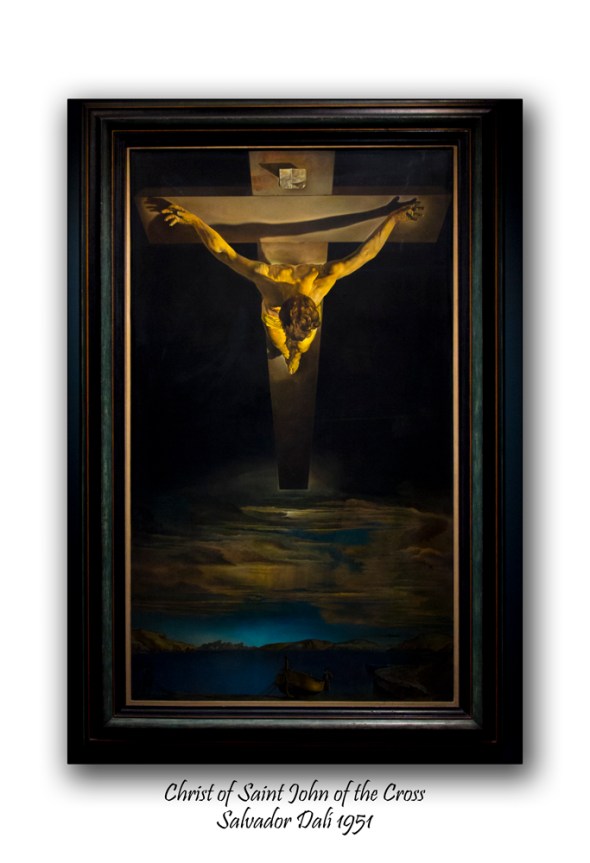
Christ of Saint John of the Cross
Salvador Dalí made in 1951
Kelvingrove Art Gallery and Museum, Glasgow
At the start of May this year (2017) I visited the Kelvingrove Art Gallery and Museum in Glasgowm, there are many great works of art there, including a full collection of works by the Glasgow boys group of artists, I will share some of their paintings very soon.
One of the most famous works of art in the Gallery is “Christ of Saint John of the Cross, by Salvador Dalí painted in 1951”, the painting has its own viewing room with subdued lighting and a set of seats, so you can spend sometime viewing this amazing work of art by Dali. It was while in this room that I captured the above image of the painting.
There is something deep and spiritually moving about this painting even if your not a believer in its subject matter.
Here are some details :
Christ of Saint John of the Cross is a painting by Salvador Dalí made in 1951. It depicts Jesus Christ on the cross in a darkened sky floating over a body of water complete with a boat and fishermen. Although it is a depiction of the crucifixion, it is devoid of nails, blood, and a crown of thorns, because, according to Dalí, he was convinced by a dream that these features would mar his depiction of Christ. Also in a dream, the importance of depicting Christ in the extreme angle evident in the painting was revealed to him.
The painting is known as the Christ of Saint John of the Cross, because its design is based on a drawing by the 16th-century Spanish friar John of the Cross. The composition of Christ is also based on a triangle and circle (the triangle is formed by Christ’s arms; the circle is formed by Christ’s head). The triangle, since it has three sides, can be seen as a reference to the Trinity, and the circle may be an allusion to Platonic thought. The circle represents Unity: all things do exist in the “three” but in the four, merry they be.
Inspiration
On the bottom of his studies for the painting, Dalí explained its inspiration: “In the first place, in 1950, I had a ‘cosmic dream’ in which I saw this image in colour and which in my dream represented the ‘nucleus of the atom.’ This nucleus later took on a metaphysical sense; I considered it ‘the very unity of the universe,’ the Christ!”
In order to create the figure of Christ, Dalí had Hollywood stuntman Russell Saunders suspended from an overhead gantry, so he could see how the body would appear from the desired angle [3] and also envisage the pull of gravity on the human body. The depicted body of water is the bay of Port Lligat, Dalí’s residence at the time of the painting.
History
The painting and intellectual property rights were acquired for Glasgow Corporation in the early 1950s by Tom Honeyman, then the Director of Glasgow Museums. Honeyman bought the painting for £8,200, a price considered high at the time although it was less than the £12,000 catalogue price, and included the copyright, which has earned Glasgow Museums back the original cost many times over.
The purchase was controversial and a petition against it, arguing that the money should be spent on exhibition space for local artists, was presented to the City Council by students at Glasgow School of Art.[6] The controversy caused Honeyman and Dalí to become friends, corresponding with each other for many years after the original acquisition.
The painting first went on display at the city’s Kelvingrove Art Gallery and Museum on 23 June 1952. In 1961 a visitor attacked the painting with a stone and tore the canvas with his hands. It was successfully restored over several months by conservators at Kelvingrove and returned to public display. In 1993, the painting was moved to the city’s St Mungo Museum of Religious Life and Art, but returned to Kelvingrove for its reopening in July 2006. It won a poll to decide Scotland’s favourite painting in 2006, with 29% of the vote.
It is said that the Spanish government offered £80 million ($127 million USD) for the painting.
Critical reception
This painting has continued to generate controversy. At the time of its purchase by Honeyman, the verdict by Modern Art critics was that producing such a traditional painting was a stunt by an artist already famous for his surrealist art. In 2009 The Guardian art critic, Jonathan Jones, described it as “kitsch and lurid,” but noted that the painting was “for better or worse, probably the most enduring vision of the crucifixion painted in the 20th century.”
In May 2013, in BBC Radio 4’s Great Lives, British poet John Cooper Clarke described this image as being utterly different from any other image of the crucifixion, as the angle of view conveys the hanging pain of this method of execution, whilst hiding the ordinarily clichéd facial expressions normally seen in such depictions.
Keighley & Worth Valley Steam Railway
Last weeks Holiday in Yorkshire was at times a true step back in time, as you can see here with the Keighley & Worth Valley Railway and our visit to Howarth, in the heart of Brontë Country we enjoyed an action packed first day out!
Keighley & Worth Valley Railway runs like a ribbon though Brontë Country, where you can expect to take in some of the most breath taking and famous landscapes in the world. A windswept land of heather and wild moors – it is hardly surprising that this area became the inspiration for the classic works of the Bronte sisters, Charlotte, Emily and Anne.
The Railway has appeared in many TV and film productions including Sherlock Holmes, Harry Potter and Where The Heart Is, A Touch Of Frost and many more. Perhaps most famously, the Railway, and in particular the charming station at Oakworth, were used as the location for the classic 1970 film The Railway Children.
If you get off the Train at Ingrow West station, you will be at the home to two award winning transport museums. You can Travel back in time at the The Ingrow Museum of Rail Travel, where restored carriages, vintage artifacts and sound and video presentations bring the past to life. The Ingrow Loco Museum boasts several locomotives as well as displays, exhibits and archive film. Both these location allow you to discover the long history that the UK has with its rail systems.
There are many special events that run throughout the year. You can get a Cream Tea . The old train lets discover the magic and glamour of the glorious days of steam-hauled, in beautiful surroundings. You can also join an annual Beer & Music Festival with over 120 real ales.
For those that like the great outdoors the railway has plenty of spectacular walks and nature trails. Every stop offers a walk, whether it’s a moorland walk or one of The Railway Children walks – you can try the Top Withens Walk, which takes you out of Haworth, the village where the Brontë sisters lived and wrote, along pathways they walked and through the moorland that inspired them.
Floating Heads Installation by Sophie Cave, Kelvingrove Art Gallery, Glasgow, Scotland.
At the start of April this year I promised myself that I would go and visit some Art Gallery’s and cultural museums one of these vists was to The Kelvingrove Art Gallery and Museum. The museum and art gallery in located in Glasgow, Scotland. It reopened in 2006 after a three-year refurbishment and since then has been one of Scotland’s most popular visitor attractions.
The gallery is located on Argyle Street, in the West End of the city, on the banks of the River Kelvin (opposite the architecturally similar Kelvin Hall, which was built in matching style in the 1920s, after the previous hall had been destroyed by fire). It is adjacent to Kelvingrove Park and is situated near the main campus of the University of Glasgow on Gilmorehill.
…
Floating Heads Installation by Sophie Cave
Just one of the many installations the Gallery has to offer is by Artist Sophie Cave …
If you Ever had that feeling that a hundred set of eyes are watching you then Sophie Cave sculptures turn the feeling into a reality!
The Floating Heads installation located in one of the open public areas in the Gallery, literally turn your head around the moment you first see this work. Sophie Cave has created over 50 sculptures of heads, each displaying different emotions including laughter and despair. The heads are completely white, but are lit so that their expressions are accentuated, which gives the installation a somewhat eerie feel. Since the installation is hung over the foyer, it is one of the first things youwill see when they enter the museum.
Its a great installation as it truly makes you stop and look at each of the heads as they slowly move around to face your direction, I relay enjoyed this work 🙂 🙂
Kelvingrove, Art Gallery, Glasgow
The path to Top Withens,Earnshaw family house Wuthering Heights : Wuthering Heights, a Poem by Sylvia Plaths
Last week we spent sometime in West Yorkshire, at Haworth the home town of the Brontë sisters, visiting the Parsonage Museum and walking upto Top Withens, the Earnshaw’s home in Emily Brontë’s novel – Wuthering heights.
The old farm house is located in some stunning landscape, the best west Yorkshire has to offer.
This is how Mr. Lockwood in the book describes his first impressions of Wuthering Heights …
” Wuthering Heights is the name of Mr. Heathcliff’s
dwelling. ‘Wuthering’ being a significant provincial
adjective, descriptive of the atmospheric tumult to which
its station is exposed in stormy weather.
Pure, bracing ventilation they must have up there at all times, indeed:
one may guess the power of the north wind blowing over the edge, by the excessive slant of a few stunted firs at the end of the house; and by a range of gaunt thorns all stretching their limbs one way, as if craving alms of the sun.
Happily, the architect had foresight to build it strong:
the narrow windows are deeply set in the wall, and the
corners defended with large jutting stones. ”
Top Withens (also known as Top Withins)
Is a ruined farmhouse near Haworth, West Yorkshire, England which is said to have been the inspiration for the location of the Earnshaw family house Wuthering Heights in the novel of the same name by Emily Brontë.
A plaque affixed to a wall reads:
“ This farmhouse has been associated with “Wuthering Heights”, the Earnshaw home in Emily Brontë’s novel. The buildings, even when complete, bore no resemblance to the house she described, but the situation may have been in her mind when she wrote of the moorland setting of the Heights. ”
Wuthering Heights a Poem By: Sylvia Plath
The horizons ring me like faggots,
Tilted and disparate, and always unstable.
Touched by a match, they might warm me,
And their fine lines singe
The air to orange
Before the distances they pin evaporate,
Weighting the pale sky with a soldier color.
But they only dissolve and dissolve
Like a series of promises, as I step forward.
There is no life higher than the grasstops
Or the hearts of sheep, and the wind
Pours by like destiny, bending
Everything in one direction.
I can feel it trying
To funnel my heat away.
If I pay the roots of the heather
Too close attention, they will invite me
To whiten my bones among them.
The sheep know where they are,
Browsing in their dirty wool-clouds,
Grey as the weather.
The black slots of their pupils take me in.
It is like being mailed into space,
A thin, silly message.
They stand about in grandmotherly disguise,
All wig curls and yellow teeth
And hard, marbly baas.
I come to wheel ruts, and water
Limpid as the solitudes
That flee through my fingers.
Hollow doorsteps go from grass to grass;
Lintel and sill have unhinged themselves.
Of people the air only
Remembers a few odd syllables.
It rehearses them moaningly:
Black stone, black stone.
The sky leans on me, me, the one upright
Among the horizontals.
The grass is beating its head distractedly.
It is too delicate
For a life in such company;
Darkness terrifies it.
Now, in valleys narrow
And black as purses, the house lights
Gleam like small change.
Artist Introduction, Paul Walls – A painter of motion
I first came across the paintings of Artist Paul Walls at an exhibition called “Currents”, held in the old friary building in Callan, County Kilkenny 2004, and instantly fell in love with his painting style and the resulting art works he produces.
I think it would be fair to say that Paul uses paint in a very loose and direct way on the canvas, I like this style very much!. Paul is one of those artists who’s work you actual need to see face to face to get a true feeling for their paintings and with Paul the depth and movement that each brush stroke has.
I feel that this style of painting is perfect for the subjects Paul captures, (Irish coastlines and countryside) on wet and windy days, days that we do so often get here.

Even when its not raining in Ireland its often windy and the above painting captures this mood so very well, Paul’s use of paint in the trees above the boats I feel captures the movement in a typical Irish day.

There will always be people who like different types of painting styles, some loving very photo realistic landscapes , others love abstract work, personally what I love most about Paul’s work is the overwhelming sense that he has captures a very active landscape and worked with it in a very pro-active fashion.
When viewing Paul’s painting you feel like you have first hand experience of the rain and the cliffs and the stormy sea.
This is the link to Paul Walls web site : Artists Paul walls
Looking at a Painting : Industrial City by Ls Lowry
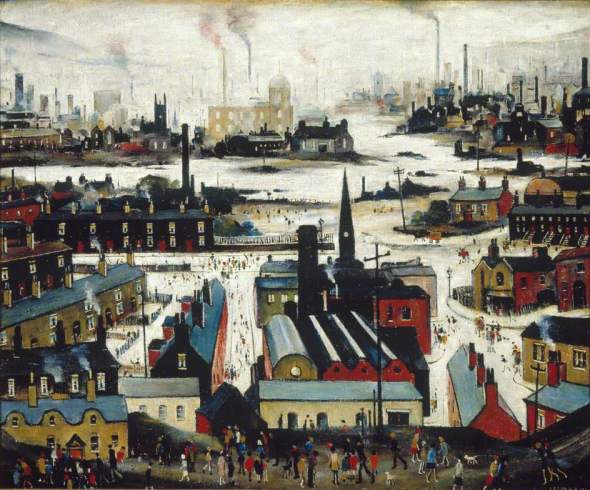
Lowry, Laurence Stephen; Industrial City; British Council Collection; http://www.artuk.org/artworks/industrial-city-176858
I have posted a couple of times since the new year, relating to the Manchester Born artists Laurence Stephen Lowry (1887–1976) he was born in Old Trafford, Salford and studied in the evening at Manchester Municipal College of Art. He was a man who rarely left the North West, finding his inspiration in the landscape of North Wales and Lancashire, and in the streets of Manchester and around Salford.
Possible this painting “Industrial City” is one of my favorite cityscapes that Lowry produced, I say possibly because he was prolific in this area of his portfolio and I love so much of his inner city works.
I grow up in Altrincham, a town only a few miles away from city center Manchester and while I missed this core era that Lowry was working in, I have lots of memories of the city looking like it does in these paintings.
During my early years I can remember these streets and factories being slowly torn down and replaced with office blocks along with new more modern houses. Its hard to imagine these days what life was like for a lot of the people captures in Lowry’s drawings and painting, living and working within the same mile, most people hardly traveling very far outside their surroundings.
Industrial City
Lowry restricted his palette to black, vermillion, Prussian blue, yellow ochre and flake white. Whilst there is a naivety in his rendition, he deftly caught the hustle and bustle of men, women and dogs on the move against a background of terraced houses, mills and factories.
The things I love most about this painting , well firstly its angle of view, Lowry paints as if he was standing on top a hill overlooking the homes and industry below. I also like very much the distance in this painting, a distance that few of the people captured in it could experience themselves at street level. To me this distance captures the expanse of the city, each small area making up the whole, yet enclosing people within their own spaces of home and work and life.
City life itself is captured here, every element of the community (Home, work, shops, play, chat, church and industrial dirt – so much of it!).
In the distance through the city smog you can just make out the hills and moors, fresh air and spaces that so clearly is just out of reach.
I feel this painting is LS Lowry at his very best, some artists go in very close with life in order to capture and reflect on it , Lowry pulls back in his view and adds in so many elements that you have to spend time exploring his work, in order for you to see the full message and story he want you to see.
This was life in a Northern English town, lowry painted it and also lived it with the people he captured!!!!
LS lowry his drawings and his teacher Pierre Adolphe Valette
At the end of last week I posted an introduction about the artist LS Lowry, he is one of my favorite artists and from my home town of Manchester in the UK. I have started a full study of his work and intend to post a few times relating to his artistic development as well as the different styles he worked in and area he selected for his art works.
It think its important to match Lowry with his night school teach Pierre Adolphe Valette, who was a French Impressionist painter. His most acclaimed paintings are urban landscapes of Manchester, now in the collection of Manchester Art Gallery. Today, he is chiefly remembered as L. S. Lowry’s tutor. I post here some of his painting as they cover a lot of the inner Manchester city areas that Lowry also later work in.
Lowry’s drawing
L S Lowry is known mostly for paintings,however the artist valued his drawings just as much.
Lowry was concerned with the qualities of line and tone. He continued to draw compulsively until the last years of his life, producing a huge range of works. His work does not just consist of his industrial scenes, but also includes highly finished drawings of the life model, careful portrait studies, rapid sketches made on location and harming sketches of children and dogs.
Lowry did not merely see drawing as a means to an end in producing his paintings, but as a significant and worthwhile medium in its own right. He would often makPierre Adolphe Valettee sketches, in situ or from memory, and later produce a much more detailed, fine piece of art from this sketch. In his early work, Lowry drew in a very strict and linear style, with little or no shading. Over time, however, he came to prefer a technique of rubbing out and over-drawing. Lowry would rub heavily worked areas of tone with his finger to achieve a dense velvety smoothness.
This technique of layering often gave his work a sense of ghostliness especially where traces of an earlier drawing can be seen underneath. Lowry did use mediums other than pencil for his drawings and his collection of work includes pastel, chalk, pen and ink, felt-tip and biro drawings.
Lowrys Night school teach was Pierre Adolphe Valette, when Lowry became a pupil of Valette he expressed great admiration for his tutor, who taught him new techniques and showed him the potential of the urban landscape as a subject. He called him “a real teacher … a dedicated teacher” and added: “I cannot over-estimate the effect on me of the coming into this drab city of Adolphe Valette, full of French impressionists, aware of everything that was going on in Paris
Valette’s paintings are Impressionist, a style that suited the damp fogginess of Manchester. Manchester Art Gallery has a room devoted to him, where the viewer may compare some of his paintings with some of Lowry’s, and judge to what extent Lowry’s own style was influenced by him and by French Impressionism generally.
The Lowry hosted an exhibition of about 100 works by Valette, alongside works by Lowry, between October 2011 and January 2012. It included paintings of Manchester from Manchester Art Gallery and loans from private owners.
I feel that you can see just how well these two artists click in the night school classes, as the influence that Valette had over Lowry clearly stayed with him all his artistic life ….
The Painting of Pierre Adolphe Valette
More painting by Pierre Adolphe Valette here
Selection of drawing by LS Lowery
Life drawings
Landscape Drawings

Francis Terrace, Salford 1969-72 L.S. Lowry 1887-1976 Presented by Ganymed Press 1979 http://www.tate.org.uk/art/work/P03277
Friday Art and Artists : LS Lowry
At the start of January while I was back in my home town of Manchester in The UK, I spent sometime with family members in visiting the Lowry Gallery in Salford, Manchester, UK.
Lowry is a much loved English artist, particularly in the North west of the UK, being born in Stretford, Manchester.
Here are some basic details about him,
Laurence Stephen Lowry was born 1 November 1887 in Barrett Street, Stretford. His father, Robert, worked as a clerk in an estate agent’s office. His mother, Elizabeth, was a talented pianist. By 1898 the family were living in Victoria Park, a leafy suburb in south Manchester, but in 1909 financial difficulties necessitated a move to Pendlebury, an industrial area between Manchester and Bolton. Lowry’s mother hated it, and so did Lowry, but, ‘After a year I got used to it. Within a few years I began to be interested and at length I became obsessed by it.’
After leaving school Lowry took a job as a clerk with a Manchester firm of chartered accountants, Thomas Aldred and Son. In 1910, after being made redundant from a second job, he became rent collector and clerk for the Pall Mall Property Company and stayed there until his retirement in 1952.
As a child he had enjoyed drawing, and he used part of his income to pay for private painting lessons with the artists William Fitz and Reginald Barber. In 1905 he began attending evening classes at Manchester Municipal College of Art. His tutor in the life drawing class there was the Frenchman Adolphe Valette, who brought first-hand knowledge of the Impressionists, such as Claude Monet and Camille Pissarro to his classes. ‘I cannot over-estimate the effect on me at that time of the coming into this drab city of Adolphe Valette… He had a freshness and a breadth of experience that exhilarated his students.’
By 1915 Lowry had begun attending evening classes at Salford School of Art, based in the Royal Technical College on the edges of Peel Park. One of his tutors there, Bernard Taylor (art critic for the Manchester Guardian) advised Lowry that his paintings were too dark. In response, Lowry tried painting on a pure white background, a technique he was to retain for the rest of his career.
Peel Park, and the views across it from the Technical College windows, appear regularly in Lowry’s work. He had begun to see the possibilities of painting what he saw on his doorstep, rather than more conventional landscapes based on the countryside nearby. The best known story Lowry told of how he became interested in the industrial scene described how, after missing a train at Pendlebury station, he saw the Acme Spinning Company’s mill turning out, ‘I watched this scene – which I’d looked at many times without seeing – with rapture.’
A closer study of Lowry
Over the next few days and weeks I want to take a much closer look at the paintings and drawings that Laurence produced, looking at the subjects that he worked with and the technique’s he used to record his world.
As an artist he has been labeled and stereotyped as a naïve “Sunday painter”, based on the way he painted his landscapes and drew people along with animals.
During this visit to the Lowry Gallery however and with the help of the guided tour, it became very clear just what a complete artist Lowry was. Having a chance to see a collection of his work from his very early days at night school, until the final works of art he produce has helped to show me just how diverse and skilled an artist he was.
The areas of his work I want to study can be seen in his work I have selected below, including (Life drawing, pencil sketches, oil paints, landscape and city scape work), I will enjoy very much looking at his art work and I hope to learn a great deal from him, for my own efforts at drawing and painting.
Art works by LS Lowry
Landscape art and Painters , Artist: Fred Cuming
Landscape painting and photography
Painting as an art form for myself feels very much like a natural progression from the art of landscape photography which is the act of recording a representation of the view you find yourself located in.
I often find myself asking what it was about an image I capture with my camera or in a sketch / painting that I liked so much that I went to the effort of working with that location in different forms and media.
This is a quote from one of my favourite landscape painters Fred Cuming, Talking about his paintings Cuming says: ‘I am not interested in pure representation. My work is about responses to the moods and atmospheres generated by landscape’
Although there are many forms of landscape art all as valid as each other, Contemporary landscape painting tends to fall into the areas of semi abstracted to completely abstract, in that each work is making an effort to extract from the selected landscape location a sense of atmosphere or a mood. This mood and atmosphere can involve colour or light or texture, or all of these things and more.
This artistic process, from pure representation or abstraction can in a completely valid way start with photography and in fact many current artists have replaced the sketch book with the film/digital camera. The question as to if this is the best thing or not will continue for a long time, some feeling that a photo simply cannot capture a good enough sense of the location or at least not in the same way as spending time in that location with a sketch book can.
Personally I feel photographs are a very important tool and can in a very valid way capture the mood and sense of a place. However I feel that you need to spend a good amount of time with your camera exploring as much as you can while your on site, walking around and finding all the different views and angles along with all the small details you can find. The aim is to return home with as complete a memory of your landscape as you can.
Here are some details of Fred Cuming as an artist along with some more of his painting…..
Artist: Fred Cuming
Fred Cuming is a painter of International standing. Born in 1930 he studied Art at Sidcup School of Art from 1945 to 1949. After completing his National Service he studied at the Royal College of Art from 1951 to 1955 where he gained a Rome Scholarship and an Abbey Minor Scholarship.
Fred was elected a Royal Academician in 1974. He has also been a member of the New English Art Club since 1960 and is the recipient of many art awards including: the Grand Prix Fine Art (1977); the Royal Academy’s House & Garden Award and the Sir Brinsley Ford Prize (New English Art Club, 1986).
Fred Cuming has exhibited his contemporary paintings world wide. His paintings feature in many private and public modern art collections. These include: Montecarlo Museum; Royal Academy of Arts; and the Guinness Collection.
Fred Cuming paintings offer a moment for reflection. Cuming creates a relationship with nature and light – inducing observers to appreciate the calming atmosphere and realisation of the beauty around us. Many of his paintings feature the counties of Kent and Sussex where the Fred Cuming artist studio is located.
Talking about his paintings Cuming says: ‘I am not interested in pure representation. My work is about responses to the moods and atmospheres generated by landscape, still life or interior. My philosophy is that the more I work the more I discover. Drawing is essential as a tool of discovery; skill and mastery of technique are also essential, but only as a vocabulary and a means towards an idea. I struggle to keep an open mind.’
Fred Cuming has exhibited at other leading British Art Galleries. In 2001 Cuming was the featured artist at the Royal Academy Summer Exhibition with an entire gallery dedicated to his art work.In 2004 he was awarded an honourary doctorate from the University of Kent.Like all Red Rag British art and Contemporary art Fred Cuming purchases can be shipped worldwide.



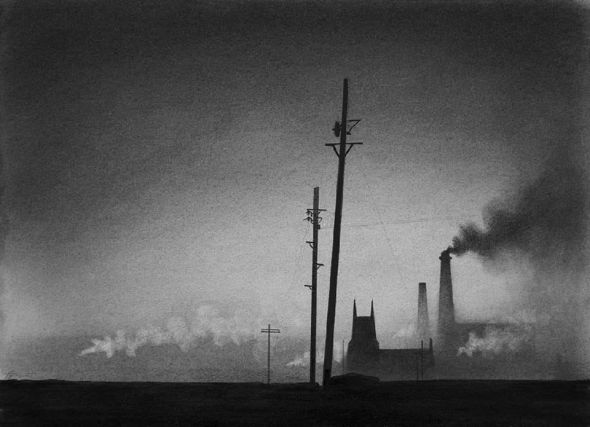
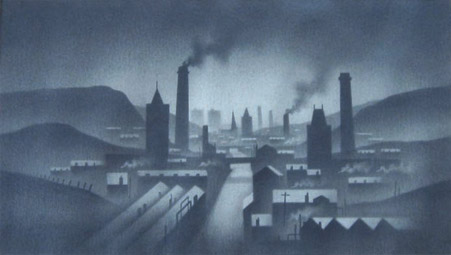
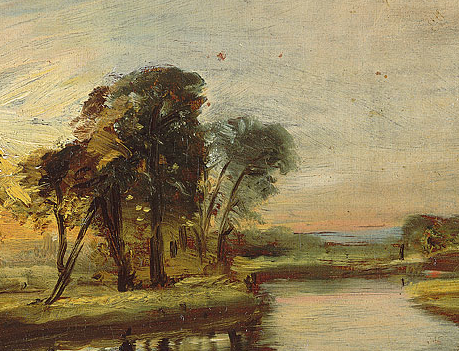

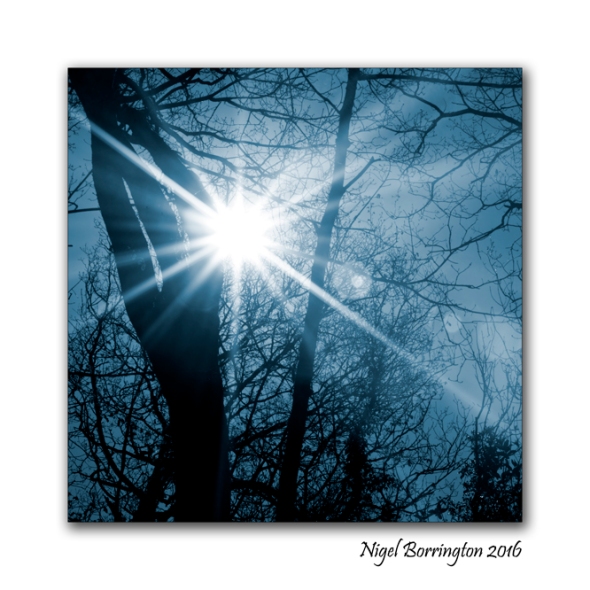
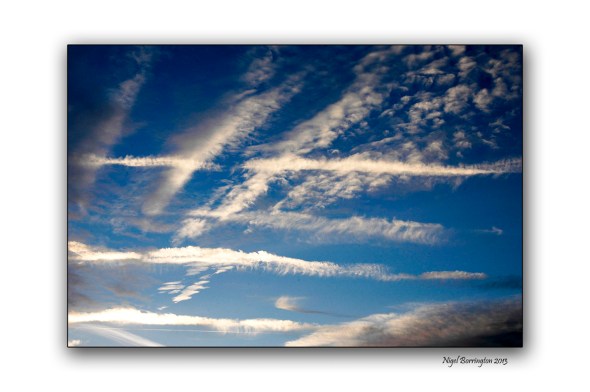






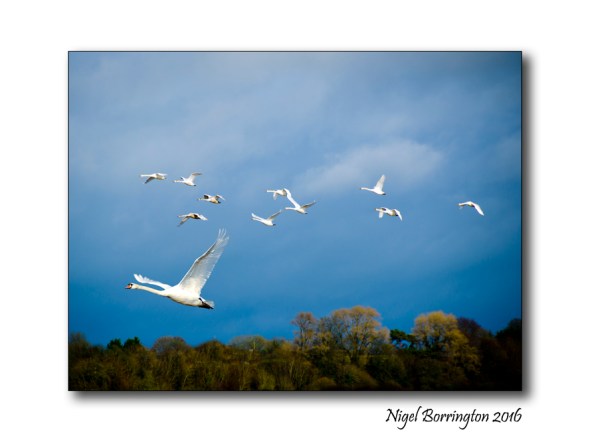













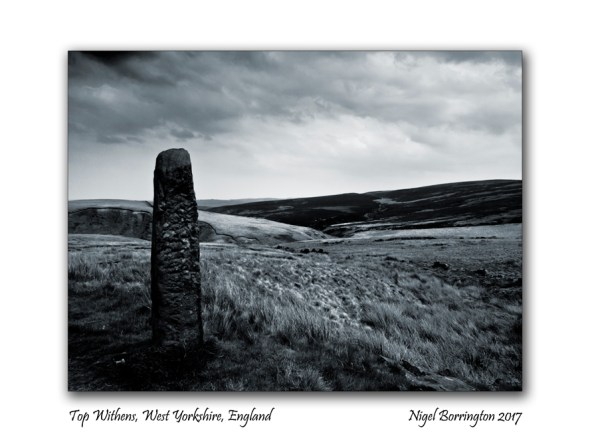
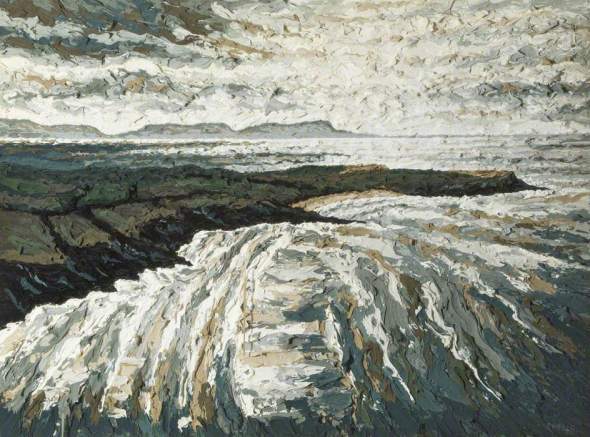
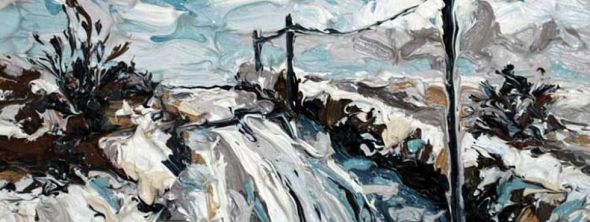
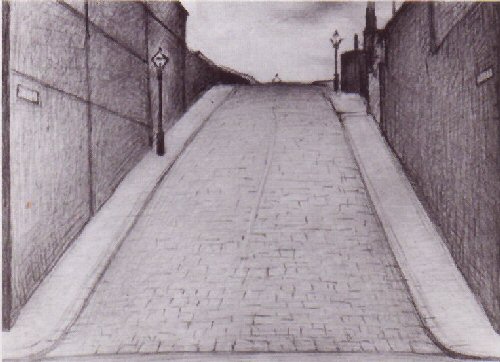







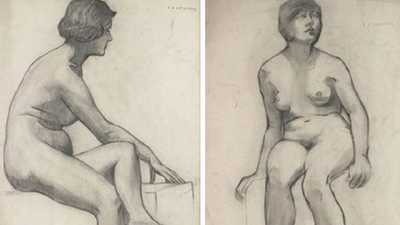




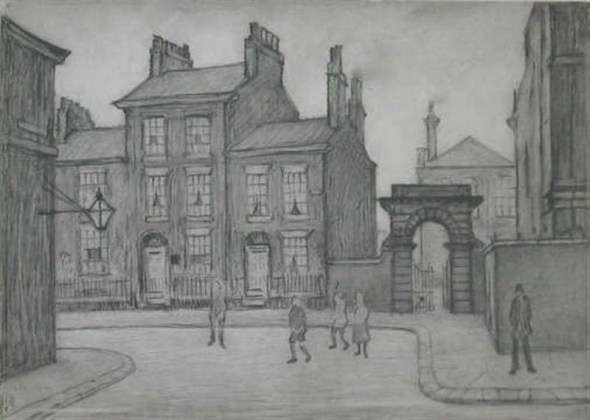

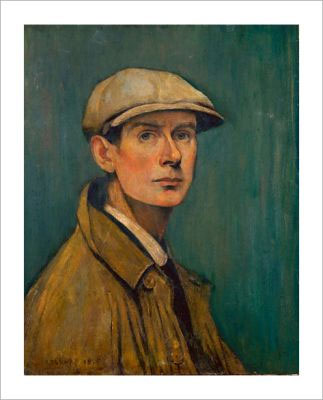




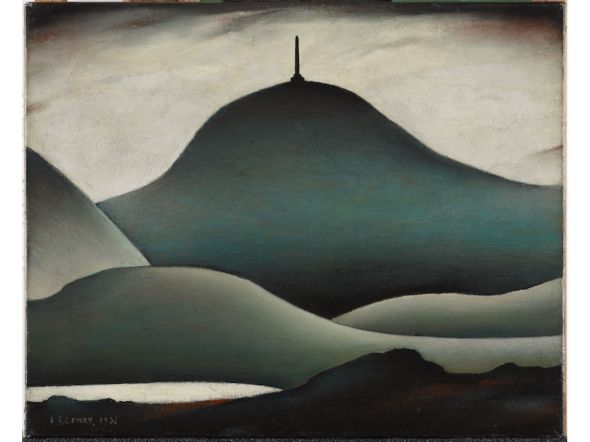




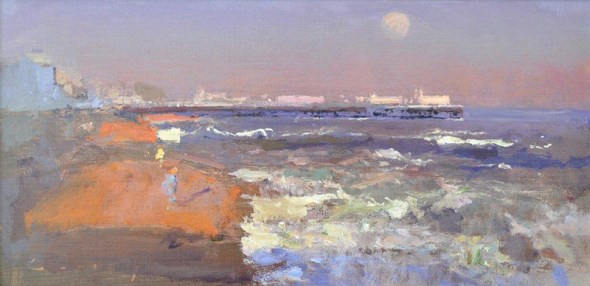


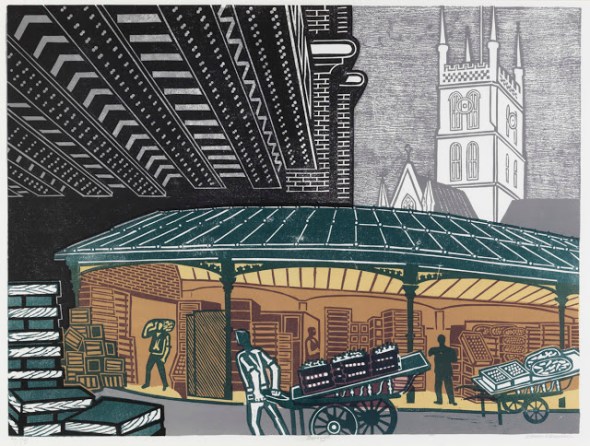



Histories Best Artists – Leonora Carrington
Leonora Carrington
kron-flower-1987
Leonora Carrington
Born 6 April 1917
Clayton-le-Woods, Lancashire, England
For me leonara Carrington is one of histories great Artists, Personally and I feel the best female artists of all time(IMO), although correctly she fought all her life again the label of “Female Artist” and just wanted to be call an ARTIST period !
Her work should be much better known and would be so but for a few facts , she was producing art at the same time as some the now best known European artist, who would later become house hold names but also she lived and worked during the Nazi period of European Art theft and art control, because of this she ended up in the end making her home in Mexico in a period when no one took anyone not working in Europe or America seriously.
In 1936, Leonora saw the work of the German surrealist Max Ernst at the International Surrealist Exhibition in London and was attracted to the Surrealist artist before she even met him. In 1937, Carrington met Ernst at a party held in London. The artists bonded and returned together to Paris, where Ernst promptly separated from his wife. In 1938, leaving Paris, they settled in Saint Martin d’Ardèche in southern France.
The new couple collaborated and supported each other’s artistic development. The two artists created sculptures of guardian animals (Ernst created his birds and Carrington created a plaster horse head) to decorate their home in Saint Martin d’Ardèche.
With the outbreak of World War II Ernst, who was German, was arrested by the French authorities for being a “hostile alien”. With the intercession of Paul Éluard, and other friends, including the American journalist Varian Fry, he was discharged a few weeks later. Soon after the Nazis invaded France, Ernst was arrested again, this time by the Gestapo, because his art was considered by the Nazis to be “degenerate”. He managed to escape and, leaving Carrington behind, fled to America with the help of Peggy Guggenheim, who was a sponsor of the arts.
After Ernst’s arrest, Carrington was devastated and fled to Spain. Paralyzing anxiety and growing delusions culminated in a final breakdown at the British Embassy in Madrid. Her parents intervened and had her hospitalised. She was given “convulsive therapy” and was treated with the drugs cardiazol, a powerful anxiolytic drug (eventually banned by some authorities, including the US Food and Drug Administration (FDA)), and Luminal, a barbiturate. After being released into the care of a nurse who took her to Lisbon, Carrington ran away and sought refuge in the Mexican Embassy. Meanwhile, Ernst had married Peggy Guggenheim in New York in 1941. That marriage ended a few years later. Ernst and Carrington never resumed their relationship.
In 1939, Carrington painted a portrait of Max Ernst, as a tribute to their relationship. The portrait was her first Surrealist work, and it was called The Inn of the Dawn Horse. It is now in the Metropolitan Museum of Art. The person in the painting is a cross between a male and a female, who is seated in a room with a rocking horse on the wall.
She also painting this portrait with him as the main character ..
Portrait of Max Ernst
Leonora Carrington
Oil on canvas
date created: About 1939
From the very first time I viewed Leonara’s art works I was captivated, her paintings are full of mystery and magical subjects, without falling into more traditional and classical mythological stories.
I found myself wanting to understand more about the fantasy world that her painting capture, a world of hidden meanings, I still don’t fully understand and here in this video she tells us not of over analyses art and just to enjoy living in the moment. However just looking at her creations you know she must have held many stories in her mind, I will keep looking and discovering!
Leonora Carrington
(6 April 1917 – 25 May 2011) was an English-born Mexican artist, surrealist painter, and novelist. She lived most of her adult life in Mexico City, and was one of the last surviving participants in the Surrealist movement of the 1930s. Carrington was also a founding member of the Women’s Liberation Movement in Mexico during the 1970s.
Looking at many of her painting you can clearly see that her life and work is the source for the movie Pan’s Labyrinth, Director: Guillermo del Toro, Writer: Guillermo del Toro , set in the falangist Spain of 1944, about a bookish young stepdaughter of a sadistic army officer escapes into an eerie but captivating fantasy world, the very same kind of fantasy worlds Leonora Carrington imagined and reflected on in her work.
The best surrealist movie of all time 🙂
Leonora Carrington – Imagination is everything !!!
Share this:
December 18, 2018 | Categories: art, art work, Artist Introduction, artists, Comment, Leonora Carrington, painting, Story telling gallery | Tags: artists, Clayton le Woods, Histories Best Artists, Lancashire, Leonora Carrington, Max Ernst, Mexican art, Mexico, Nigel Borrington, surrealism, surrealist art | 6 Comments